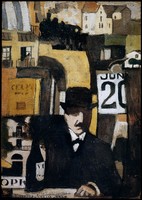Joaquín Torres-García
Joaquín Torres-García (Uruguayan artist, 1874-1949)
Torres-García did not live in Uruguay for most of his life yet he claimed himself as a Latin American artist. He started his art from noucentisme in which he believed that art is a way to reach the truth by going back to the classical time. More specifically, he was paying attention to the time inside the picture. In his work “Figure with the Cityscape, 1917” Torres-García used a different technique to present the time. He collapsed all he element of a city and then put them together to show the rhythm of the hustling lives happening around the static man at the front. Although these paintings had a very different style than his later works, there were hints showing that Torres-García were seeking a way to perform the kind of art that everyone around the world could understand and could last forever throughout time.
A big change in Torres-García’s painting happened when he was in Paris. He met Mondrain who introduced him to concrete art and that was also the time he got exposed to Theosophy. Torres-García then created a few pieces using the concept of concrete art such as “Constrcution, 1930.” During that period, along with concentrating on the skills of modern art, he began to look for his heritage. Torres-García decided to Inca culture as his inspiration in creation. He painted “Constructive Painting in Red and Ochre” which he used the objects in the drawing as symbols. He used grids and with earth-tone color as a representation of pre-Columbian culture. In addition, these symbols were a part of language created by himself. After his return to Uruguay, he started to teach and worked on spreading his idea of presenting the uniqueness of Latin America to the public. His public art “Cosmic Monument, 1937-1938” was a replica of “Gate of the Sun.” Torres-García not only created more connection of concrete art and pre-Columbian art but also paid attention of bring art to the community for a broader audience. At this time, his concentration had become finding the universal language to place in his art and the making of construction art.
The Inca empire was located in modern-day Peru. It was the greatest empire in pre-Columbian America. Inca textiles were a big part in Inca culture which is not only a piece of fabric but also a symbol of wealth and status. The link below tells more about the story of Inca textiles:
"Inca Textile"
http://www.ancient.eu/article/791/




